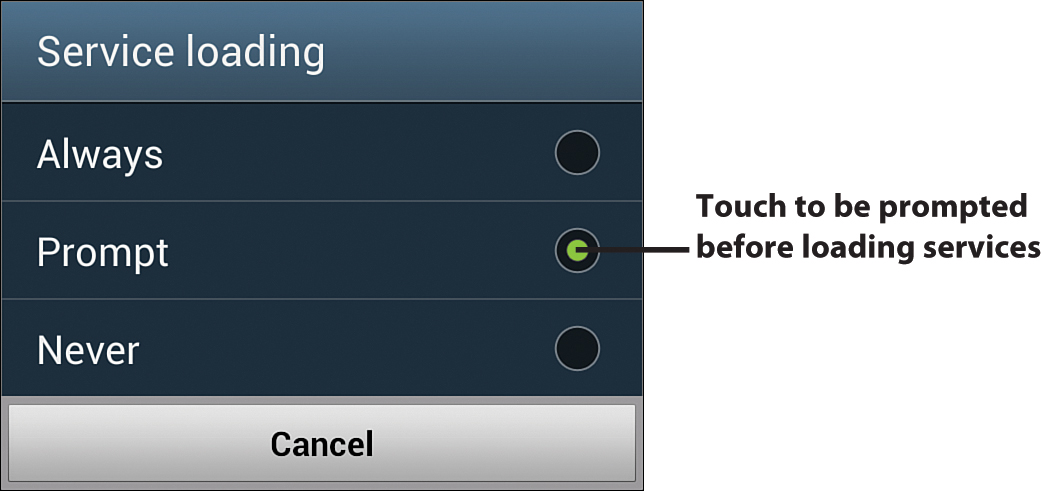8. Phone, SMS, and MMS
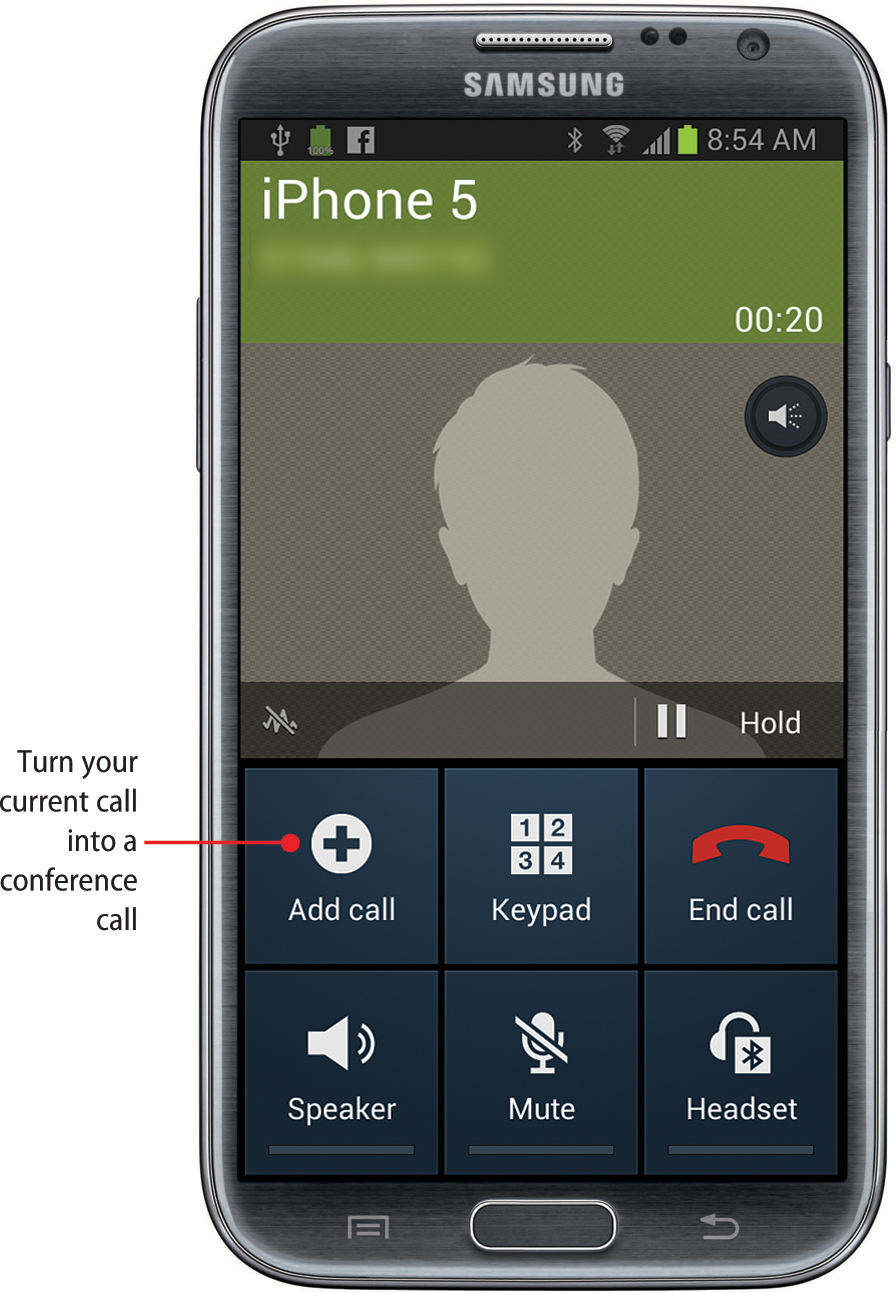
In this chapter, you find out how to make and take phone calls and send instant messages on your Galaxy Note II. Topics include the following:
→ Making phone calls
→ Making conference calls
→ Sending and receiving text messages
→ Sending and receiving multimedia messages
As a cellular phone, your Galaxy Note II includes powerful features that enable you to make phone calls swiftly and easily. Your Galaxy Note II can also send both text-only instant messages and multimedia instant messages by using the Messaging app.
Phone
With the Phone app, you can quickly make and receive calls across the cellular network. When you need to talk to more than one other person, you can easily turn your current call into a conference call.
Open and Navigate the Phone App
The Phone app contains four tabs that enable you to make calls in various ways and to track the calls you receive.
1. On the Home screen, touch Phone.

Opening the Phone App from the Lock Screen
If your Galaxy Note II uses swipe to unlock the Lock screen, you can open the Phone app directly from the Lock screen. Instead of swiping open space, touch the Phone icon on the Lock screen and swipe from there.
2. If the Keypad tab does not appear at the front, touch Keypad.
3. Touch the keys to dial a number.
4. If the Phone app displays a suggested contact with a matching number, you can tap the contact if it is the one you want.
5. Touch to place the call.
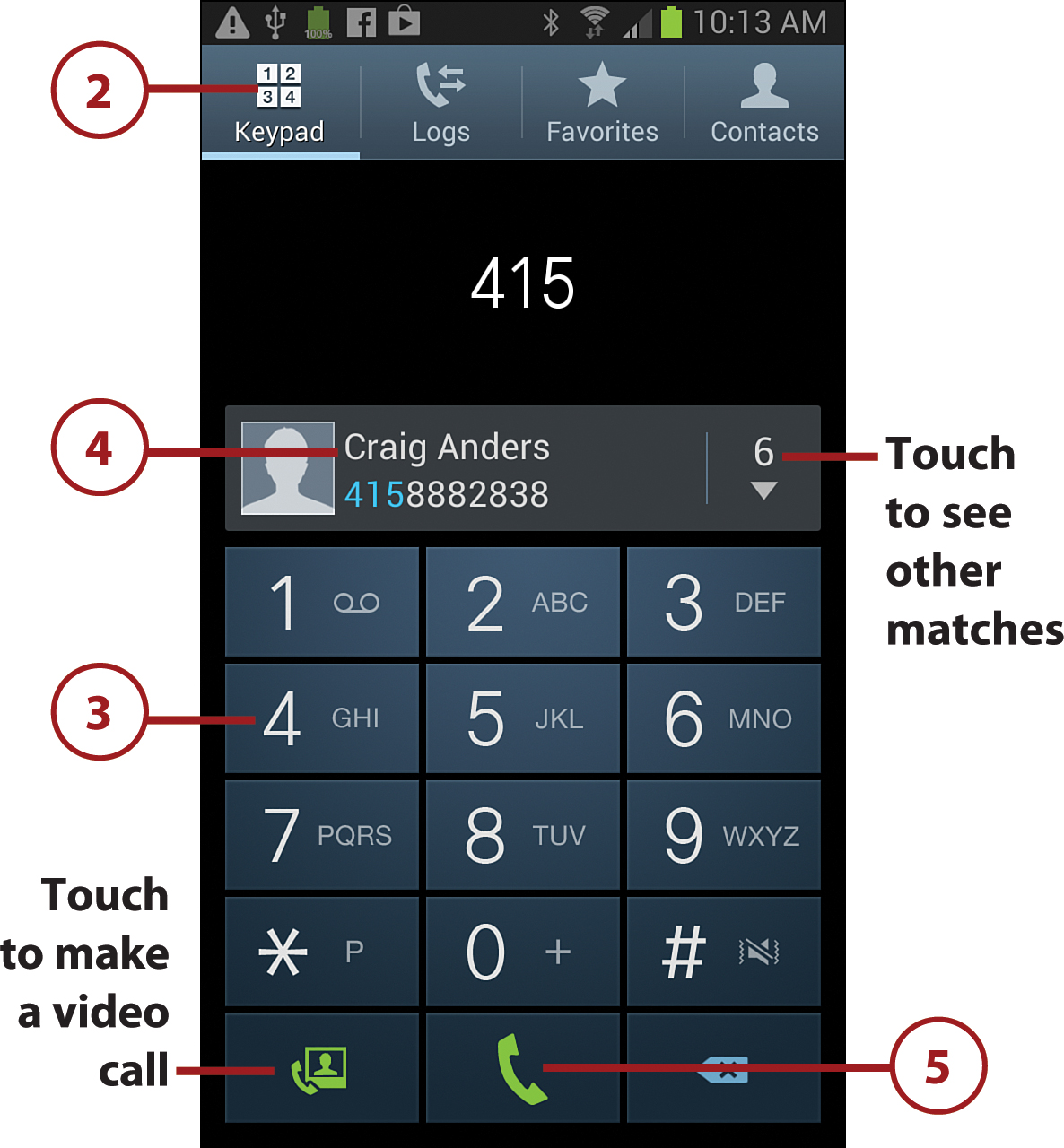
6. Touch Logs to see a list of the calls and messages you have placed and sent.

Making Your Logs Display the Information You Need
At first, the Phone app displays all your logs, but you can narrow down the view to specific logs so you can more easily find the calls and messages you need. You learn to do this later in this chapter.
7. Touch Favorites to see lists of Favorites and Frequently Contacted contacts.
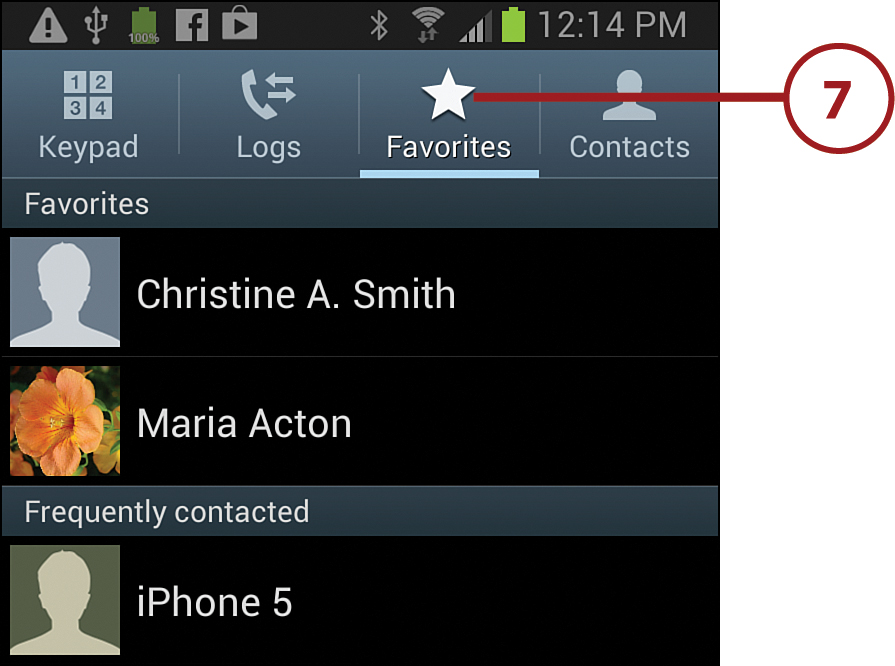
8. Touch Contacts to display your full contacts list in the Contacts app.
9. Touch Phone to return to the Phone app.

Receive a Call
When someone phones your Galaxy Note II, you can accept the call, reject it, or reject it and send a text message.
Accept a Call
1. When the phone rings, look at the contact name if it is available or the phone number if it is not, and decide whether to take the call.
2. Touch and drag to accept the call.

3. Touch to switch to the speaker.
4. Touch to enable extra volume on the speaker.
5. Touch to switch to the headset.
6. Touch to mute the call. Touch again to turn off muting.
7. Touch to place the call on hold. Touch Unhold, which replaces the Hold button, when you are ready to restart the call.
8. Touch to end the call.
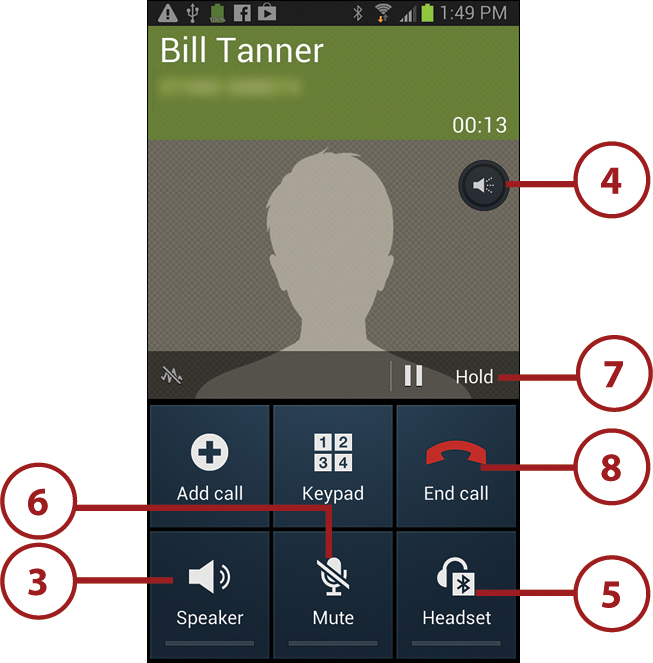
Reject a Call
If you do not want to accept the call, you can reject it so that it goes to your voicemail.
1. When the phone rings, touch and drag to reject the call.

The call goes to voicemail, and your Galaxy Note II displays the screen you were using before the call came in.
Reject a Call and Send a Message
Instead of simply declining a call and sending it to your voicemail, you can send a text message straight back to the caller. Your Galaxy Note II provides a selection of canned messages for general needs. You can also create your own messages or type custom messages for particular calls.
1. When the phone rings, touch and drag up to open the Reject Call with Message shade.

2. Touch to send one of the canned messages.
3. Touch to create and send a custom message.

4. Type the message.
5. Touch to send the message.

Creating Your Own Canned Reject Messages
To create and save your own canned reject messages, open the Phone app and touch the Menu button. On the menu, touch Call Settings. On the Call Settings screen, touch Set Reject Messages. On the Reject Messages screen, touch Create to create a new message, or touch an existing message to open it for editing.
Handle Missed Calls
If you miss a phone call, you can quickly locate it in the Phone app’s logs so that you can return it.
1. Swipe to unlock your Galaxy Note II and go straight to the Phone app. When there are missed calls, the Phone app displays the Logs tab first.

2. If the Logs tab is not displayed, touch to display it.

3. If you want to change the logs displayed, touch the Menu button.
4. Touch View By.

5. Touch the button you want to filter by. For example, touch Missed Calls.

6. Touch a call to see its details.

7. Touch to phone the contact back.

Place a Call
When you need to make a phone call, you can dial it manually using the keypad. But usually you can make a call more quickly by placing the call from a contact entry or by using your voice.
Dial with the Keypad
You can use the keypad to dial a call both when you need to call a number for which you do not have a contact and when you can remember part of the number for a contact.
1. In the Phone app, touch the Keypad tab to bring it to the front.
2. Start typing the phone number. If you are typing to recall a number, type the part you remember.
3. If Phone suggests the correct number, touch to dial it.
4. Alternatively, touch to display other matching numbers.
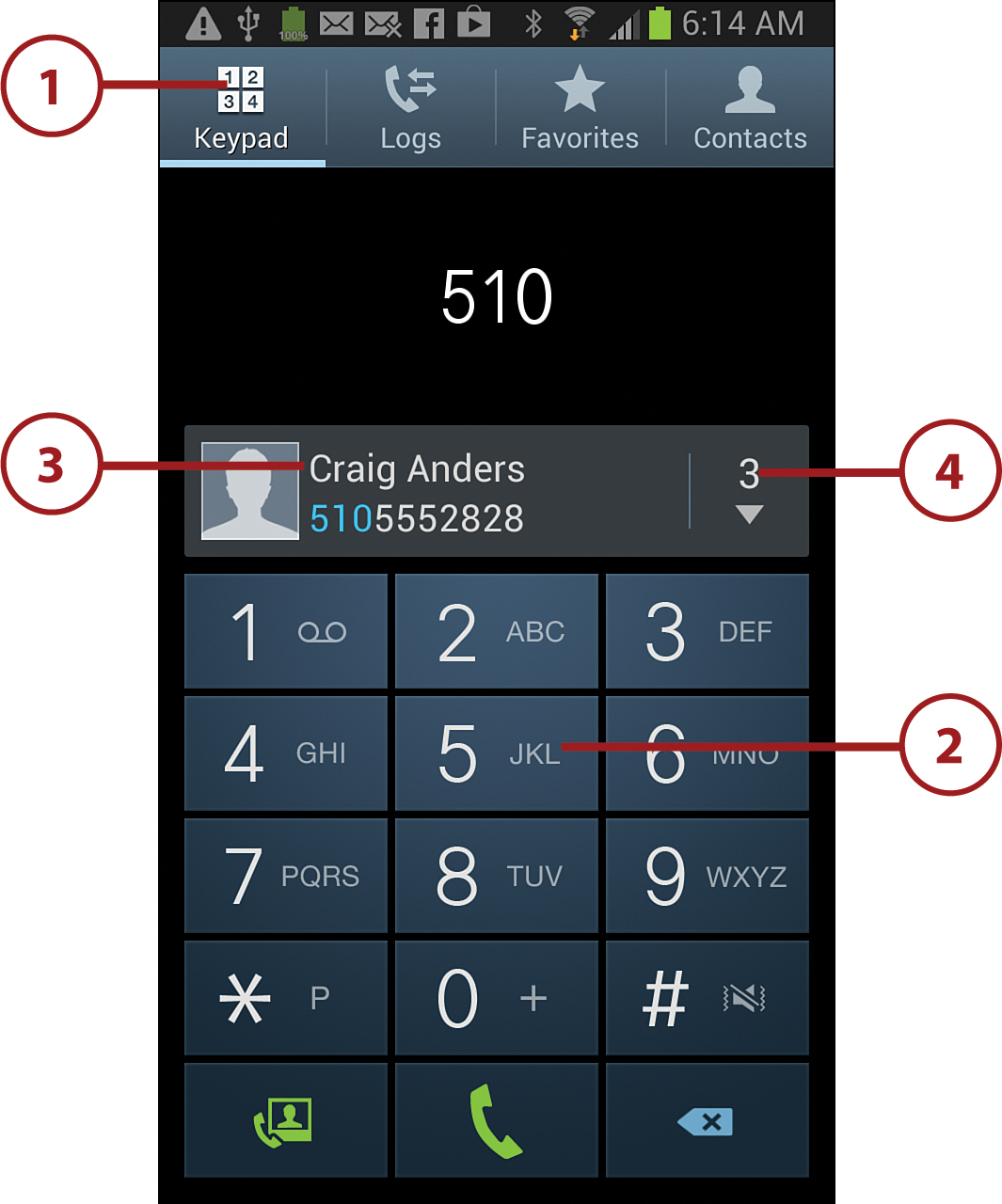
5. Touch the number you want to dial. If none of the suggestions are correct, touch Cancel and finish dialing the number manually.

6. Touch to dial the number.

Dial from a Contact Entry
If you know you have a contact entry for the person you want to dial, you can start from that contact entry.
1. In the Phone app, touch the Contacts tab to bring it to the front. Android switches from the Phone app to the Contacts app.
2. Touch the contact to display the contact’s details.
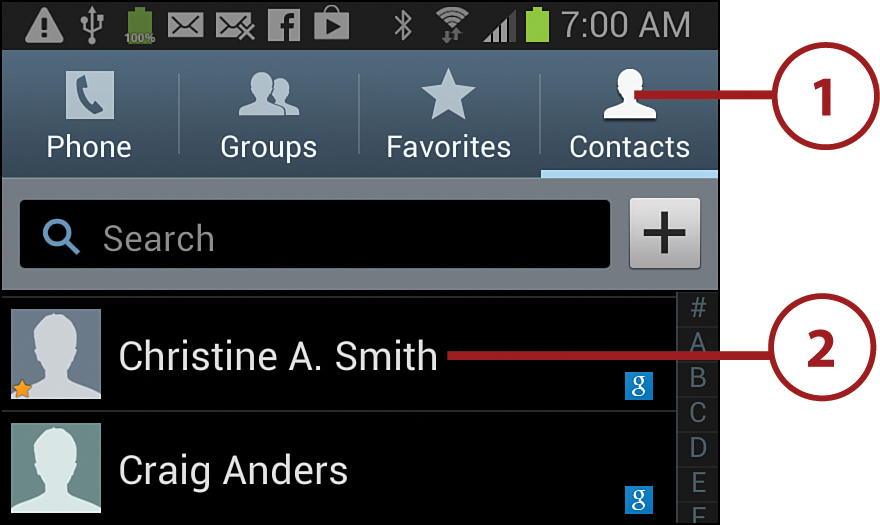
Starting a Call from the Contacts App
Instead of launching the Phone app and then touching the Contacts tab to go to the Contacts app, you can start a call directly from the Contacts app. Touch Contacts on the Home screen or the Apps screen to launch the Contacts app, touch the contact to display his or her details, and then touch the Call button or the Video Call button.
3. Touch the number you want to call.

1. On the Apps screen, touch S Voice.
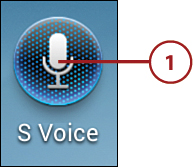
2. Say, “Call,” followed by the contact’s name; if the contact has multiple phone numbers, say the type of number as well. For example, say, “Call Dana Smith mobile,” or, “Call Maria Ramirez work.”
3. Wait while S Voice dials the call. The Dialing screen appears.

Control a Call and Make Conference Calls
After accepting or establishing a phone call, you can control it from the Call screen.
1. Touch Hold to put the call on hold. When you do this, the person at the other end of the call normally receives an automatic announcement that you have put them on hold.

2. Touch Unhold to remove the hold.
3. Touch Keypad to display the keypad.
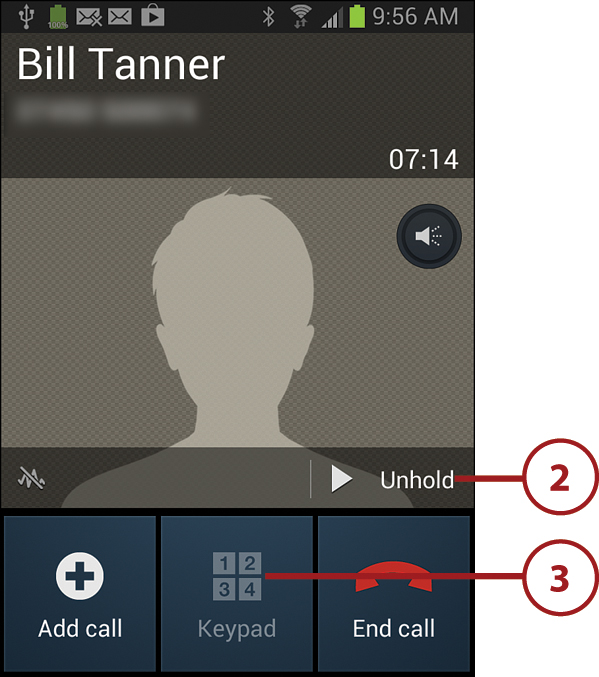
4. Touch the keys to navigate through voicemail systems.
5. Touch Hide when you no longer need the keypad.
6. Touch Mute to mute the call. Touch again to remove muting.
7. Touch Headset to switch the audio to the headset.

8. Touch Speaker to switch the audio to the speaker.
9. Touch to enable or disable extra volume.
10. Touch to end the call.

Using Other Apps During a Call
During a call, you can use most other apps freely, but you cannot play music or video. You can take photos with the Camera app, but you cannot shoot videos. To switch to another app, either use the Recent Apps list or press the Home button and use the Apps screen as usual. While you are using another app, your Galaxy Note II displays a green bar at the top of the screen to remind you that you are in a call. When you return to the Phone app, your Galaxy Note II displays a panel of options. Touch Return to Call in Progress to go back to your call.

Make Conference Calls
You can quickly turn your current call into a conference call by adding further participants.
1. On the call screen, touch Add Call.
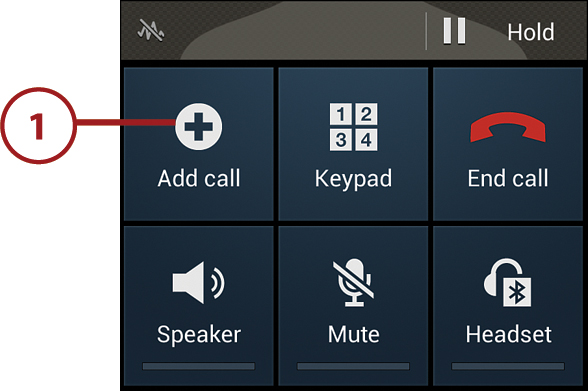
2. Dial the call in the most convenient way. For example, touch the Contacts tab, touch the contact in the list, and then touch the Call button on the contact’s details screen.
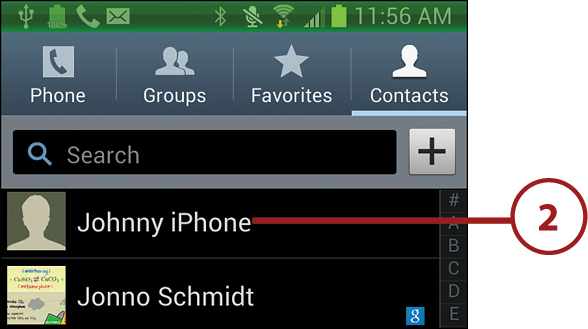
3. When your Galaxy Note II has established the new call, the original caller is on hold. Touch Merge to merge the calls.
4. When you are ready to finish the call, touch End Call.

1. On the Home screen, touch Phone.

2. Touch the Menu button.
3. Touch Call Settings.
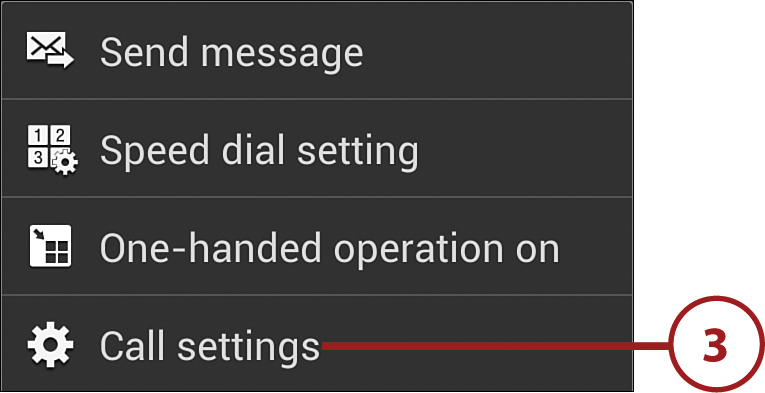
4. Touch to set up Auto Reject mode.
5. Touch to edit your canned reject messages.
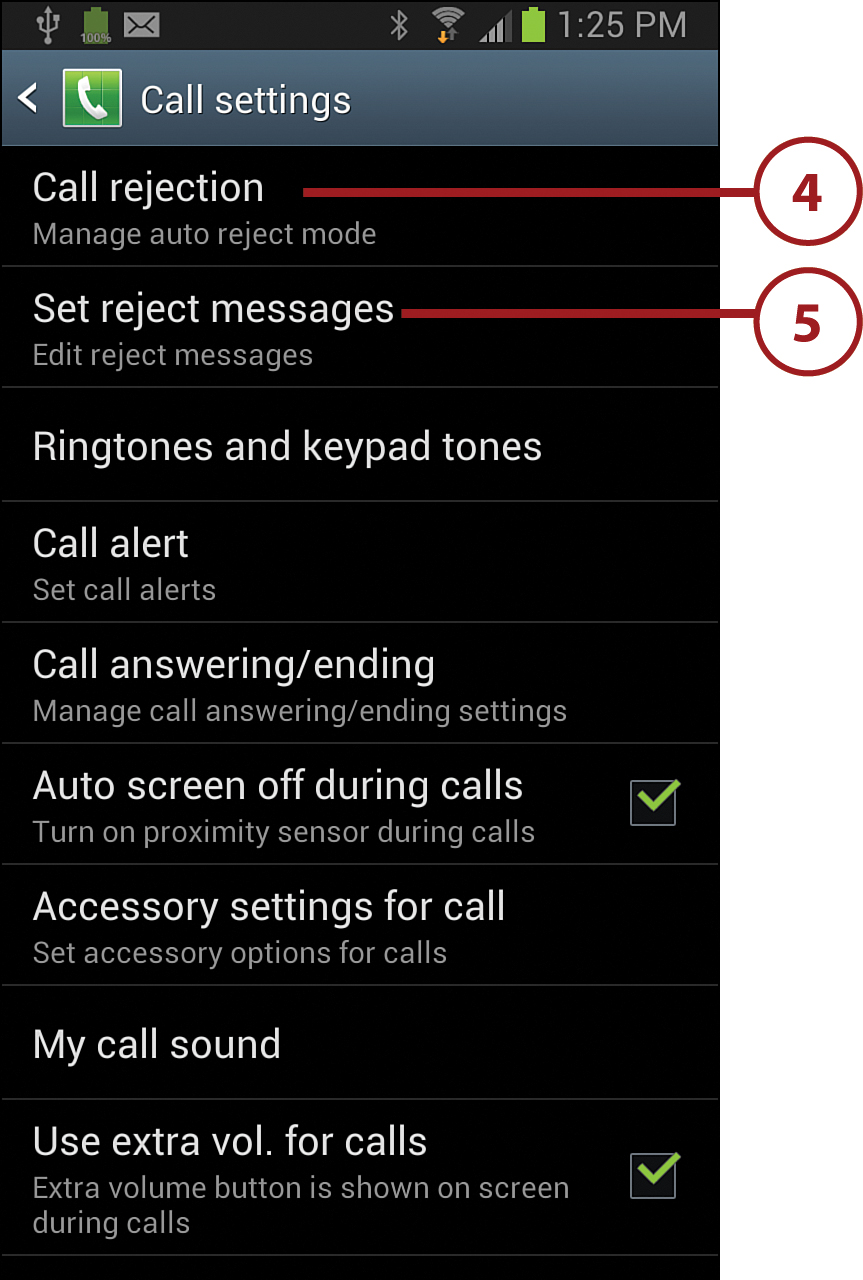
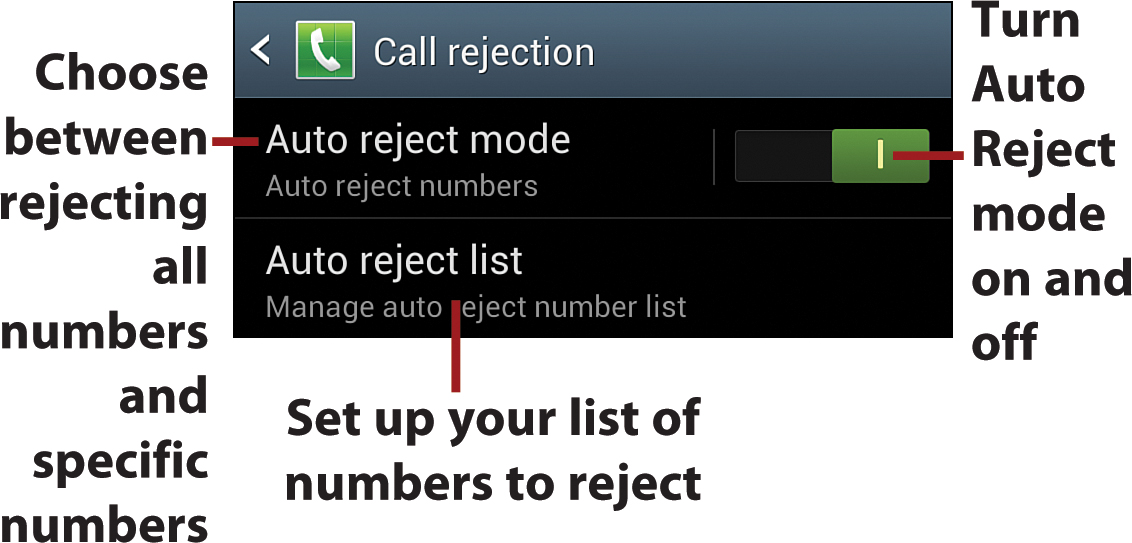
What Does Auto Reject Mode Do?
Your Galaxy Note II’s Auto Reject mode can automatically reject either all calls or only the numbers on a list you provide. Automatically rejecting all calls can be useful for meetings and social occasions when you do not want to be disturbed. Automatically rejecting specific numbers enables you to avoid calls from people you do not want to talk to. You can turn Auto Reject mode on and off by moving the Auto Reject Mode switch.
6. Touch to choose your ringtones, keypad tones, and vibrations for calls.
7. Touch to choose options for vibrations, cell status tones, and alerts during calls. You can choose whether your Galaxy Note II vibrates when someone answers your call and when they hang up. You can also choose which status tones and alerts to receive during calls and which to suppress.
8. Touch to choose whether pressing the Home key answers an incoming call and whether pressing the Power button ends an ongoing call.
9. Touch to turn off the Galaxy Note II’s proximity sensor during calls.
10. Touch to choose Phone settings for wired headsets and Bluetooth headsets.
11. Choose to customize how the audio on phone calls sounds. You can choose among Soft Sound, Clear Sound, Optimized for Left Ear, and Optimized for Right Ear options, or choose Off to use standard audio.
12. Touch to make the Extra Volume button appear during calls so you can pump up the sound if it is too quiet.

13. Scroll down and touch to make the Galaxy Note II ring more loudly when it detects it is in a pocket or a bag.
14. Touch to set up call forwarding for voice calls and video calls.
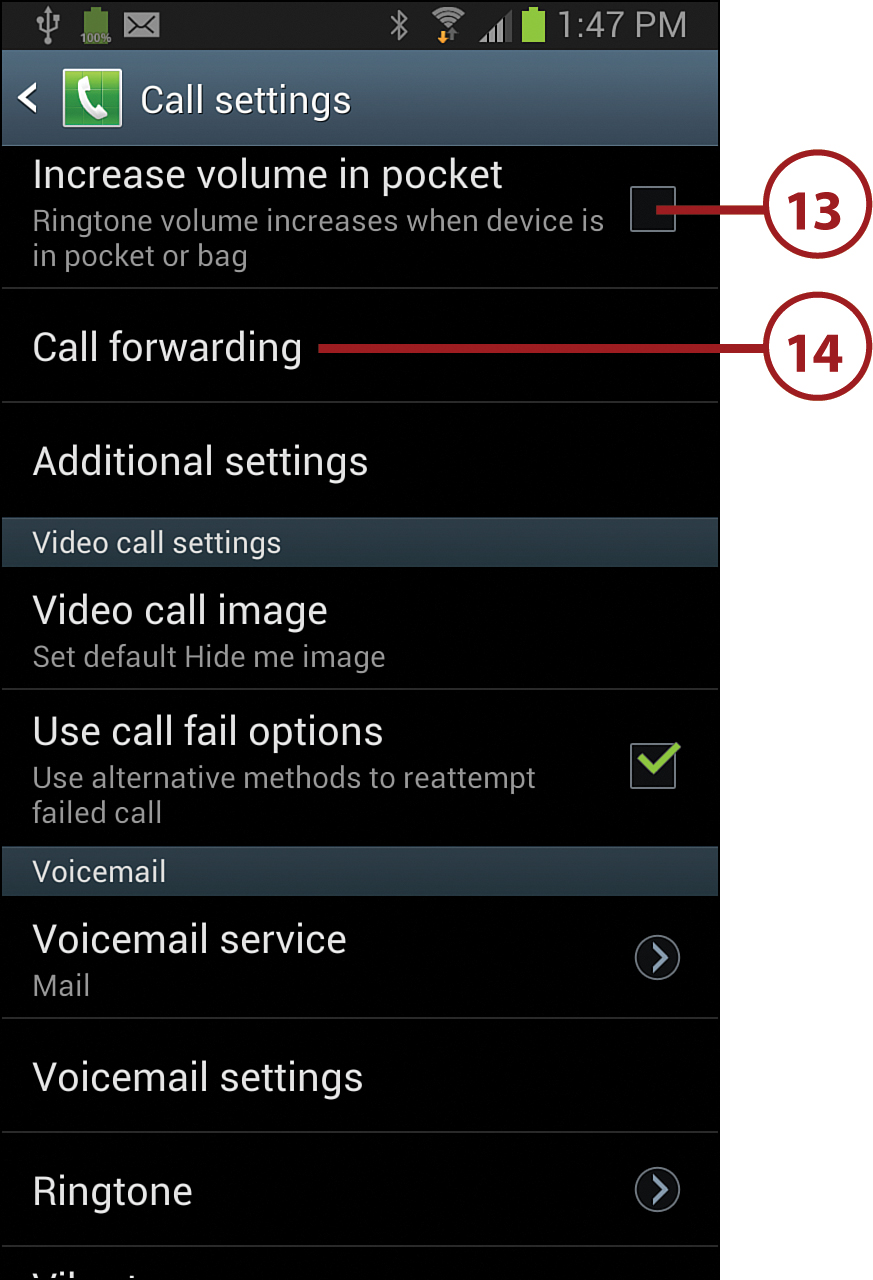
15. Touch to choose further settings, including Caller ID, Call Waiting, and Noise Reduction.
16. Touch to set a default image that appears in video calls when you hide yourself.
17. Touch to allow your Galaxy Note II to use alternative technologies to establish video calls that it cannot make directly.
18. Touch to set up your voicemail service.
19. Touch to adjust voicemail settings.
20. Touch to choose your ringtone for announcing voicemail.
21. Scroll down.
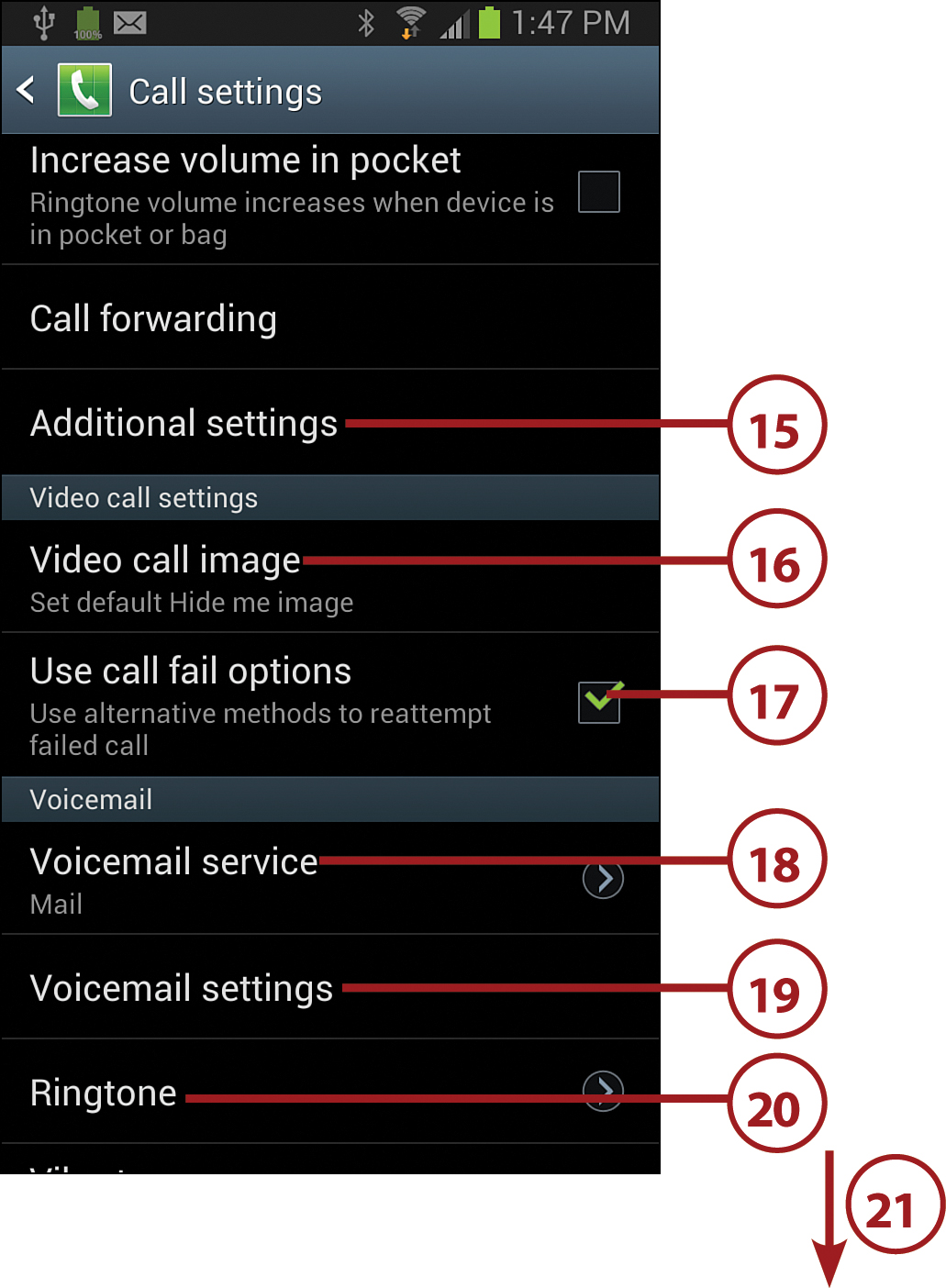
22. Touch to choose vibration settings for voicemail.
23. Touch to manage your accounts for making calls across the Internet.
24. Choose when to use Internet calling: for all calls, even when a mobile network is available; for Internet calls only; or to prompt you for each call.
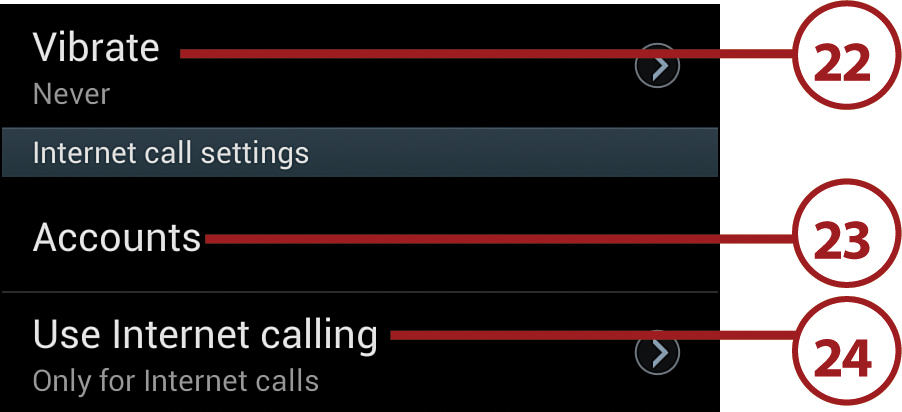
SMS and MMS
Short Message Service (SMS), also known as text messaging, has been around for a long time and is still used today as the primary form of communication for many younger phone users. Multimedia Message Service (MMS) is a newer form of instant messaging that can contain pictures, audio, and video as well as text. Your Galaxy Note II can send and receive both SMS and MMS messages.
Get to Know the Messaging App
The Messaging app is what you use to send and receive text messages. This app has all the features you need to compose, send, receive, and manage these messages.
1. Touch the Messaging icon on the Home screen.
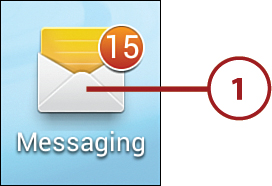
2. Touch to compose a new text message.
3. Touch the sender’s picture to show the Quick Connect bar.
4. Touch a message thread to open it.
5. Touch the Menu button to change the Messaging app settings or to delete message threads.
6. Look here for how many unread messages are in a message thread.

Manage Settings for the Messaging App
You use the settings of the Messaging app to manage how the app handles your SMS and MMS messages. Before you actually start working with SMS and MMS, let’s take a look at the settings.
1. Touch the Menu button.
2. Touch Settings.

3. Touch to choose which colors and styles of bubbles the app uses for messages.
4. Touch to choose which background the app uses for messages.
5. Touch to use a split view when you turn your Galaxy Note II to landscape orientation.
6. Touch to enable changing text size by pressing the volume buttons.
7. Touch to enable or disable automatically deleting old messages when the limits you set in steps 8 and 9 are reached.
8. Touch to change the text message limit per thread (or conversation). The maximum number you can enter is 999. When the limit is reached, Messaging deletes messages within the thread or conversation using the first in, first out (FIFO) method.
9. Touch to change the multimedia message limit per thread (or conversation). The maximum number you can type is 999. When the limit is reached, messages within the thread or conversation are deleted using the first in, first out (FIFO) method.
10. Touch to edit your list of text templates. These are canned messages such as, “When can we meet?” and, “Please call me when you get this message.”
11. Scroll down for more settings.
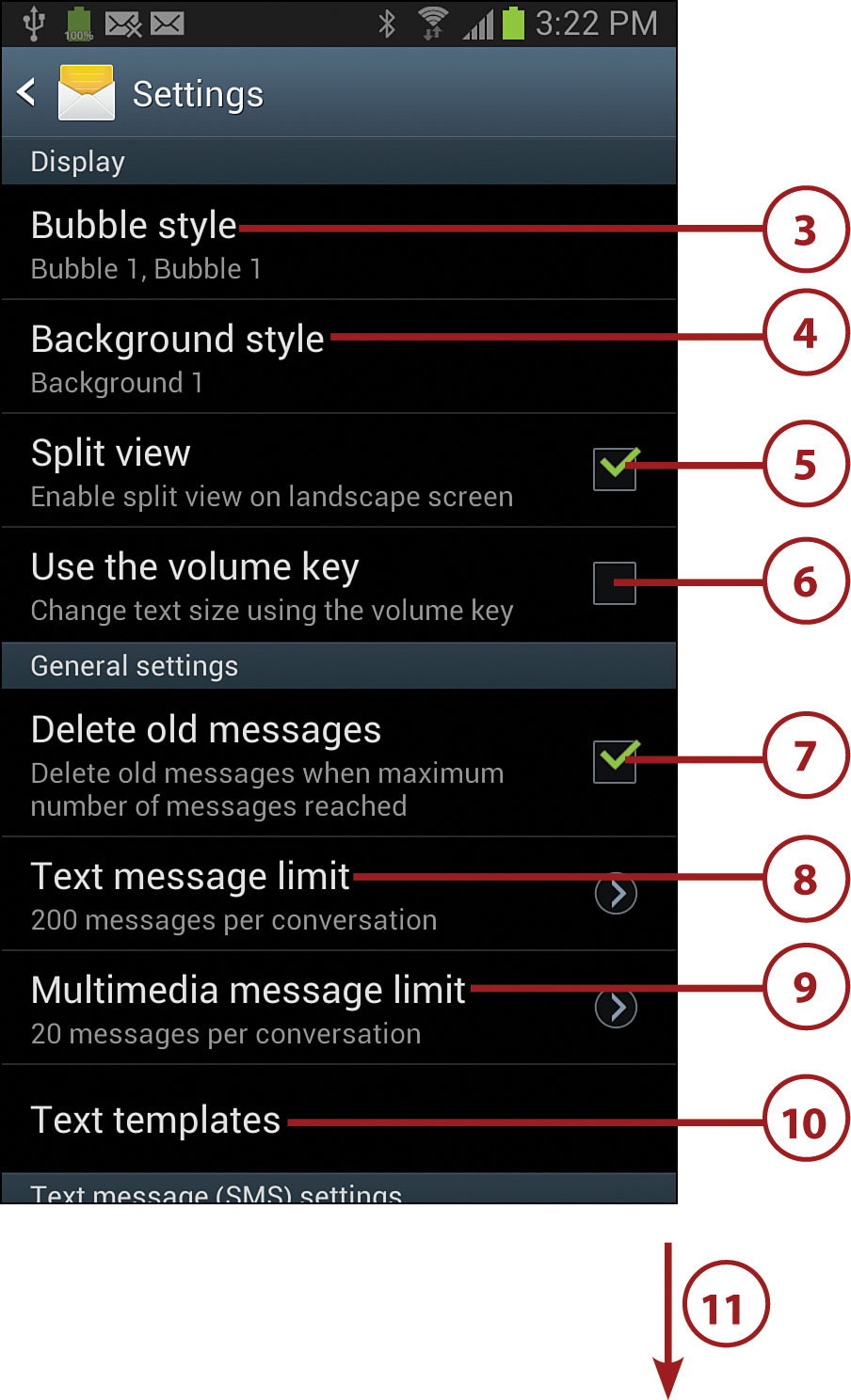
12. Touch to enable or disable delivery reports. Although your Galaxy Note II supports this feature, it is not well supported by other phones, so you might not get delivery reports from some recipients.
13. Touch to manage the text messages stored on your Galaxy Note II’s SIM card.
What Does the Manage SIM Card Messages Command Do?
Many old cell phones store text messages on the SIM card and not in the phone’s memory. If you have just upgraded from an older phone, you might still have text messages on the SIM card that you would like to retrieve. Touch Manage SIM Card Messages on the Settings screen in the Messaging app to display the Manage SIM Card Messages screen. You can then copy the messages to your Galaxy Note II’s memory and copy the senders to your contacts in the Contacts app.
14. Touch to change your message center number. This is the number at your carrier that the Galaxy Note II contacts to retrieve your messages.
15. Touch to choose the input method for composing SMS messages. Your choices are GSM alphabet, Unicode, or Automatic. Change the default setting only if you are sure you need to.
16. Touch to enable or disable automatically requesting a delivery report for each multimedia message you send.

17. Touch to enable or disable a read report for each multimedia message you send.
What’s the Difference Between a Delivery Report and a Read Report?
A delivery report indicates that the message has reached the destination device. A read report indicates that the message has been opened for viewing. There is still no guarantee that whoever opened the message has actually read it, let alone understood it.
18. Touch to enable or disable automatically retrieving multimedia messages.
19. Touch to enable or disable automatically retrieving multimedia messages when roaming.
Don’t Auto-Retrieve MMS While Roaming
Disable the automatic retrieval of multimedia messages when you travel to other countries because automatically retrieving these messages when you’re roaming can result in a big bill from your provider. International carriers love to charge large amounts of money for people traveling to their countries and using their networks. The only time it is a good idea to leave this enabled is if your carrier offers an international SMS or MMS bundle where you pay a flat rate up front before leaving. When you have auto-retrieve disabled, you see a Download button next to a multimedia message. You have to touch it to manually download the message.
20. Scroll down for more settings.

21. Touch to choose the Creation mode, which controls which content you can include in multimedia messages.
What Is the Creation Mode for Multimedia Messages?
The Creation mode feature lets you control which content Messaging allows you to include in messages. Choose Restricted to have the Galaxy Note II prevent you from including content that the recipient might not be able to receive or view. Choose Warning to have the Galaxy Note II warn you about such content but allow you to proceed. Choose Free to be able to include potentially problematic content without warning.
22. Touch to enable or disable a warning when you add content to an SMS message that makes it change to an MMS message.
23. Touch to enable or disable receiving messages “pushed” from the server. Push messages arrive at your Galaxy Note II shortly after they arrive at the server, which is usually faster than waiting until the Galaxy Note II checks for messages.
24. Touch to choose how to handle remote requests to load services. Your choices are Always, Prompt, and Never.
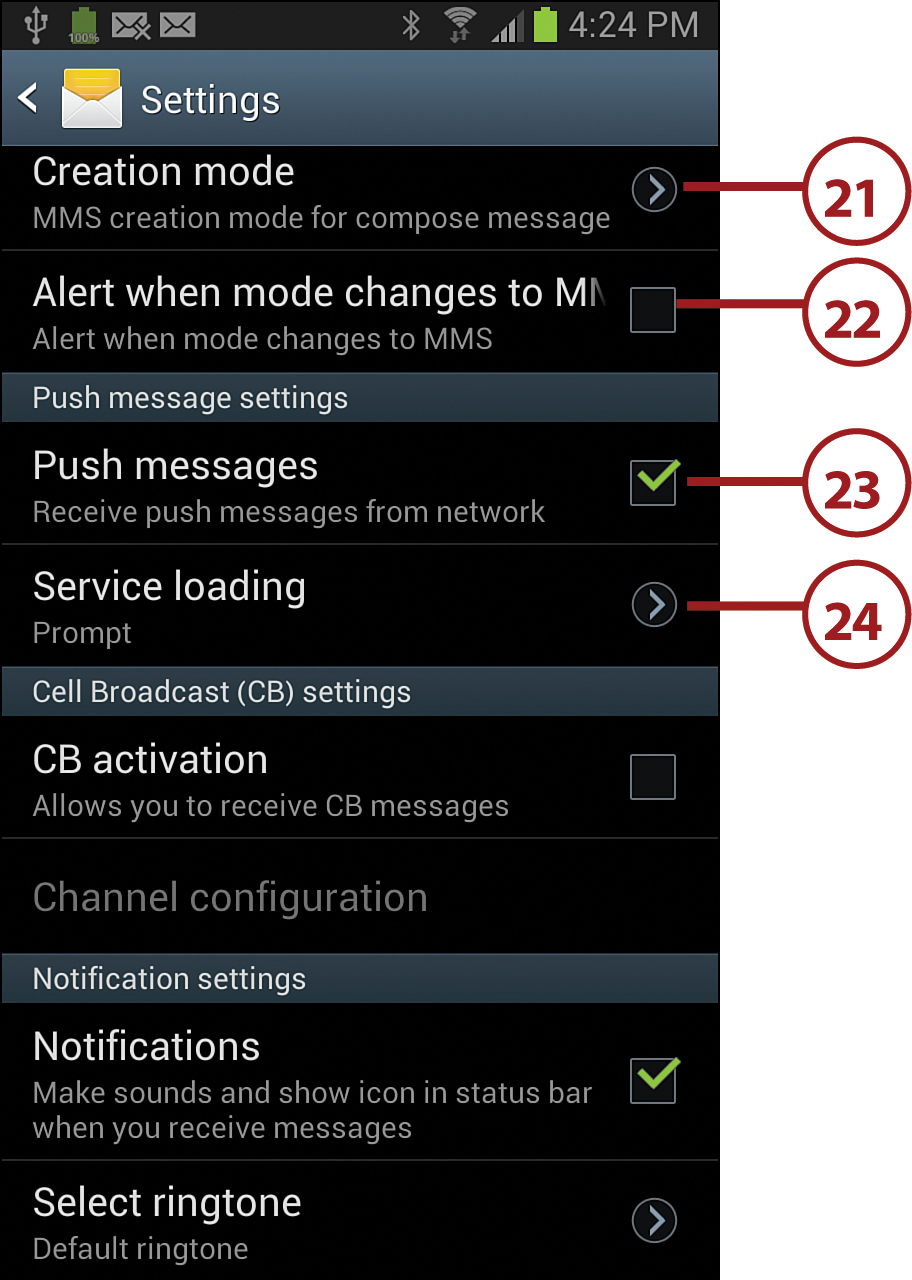
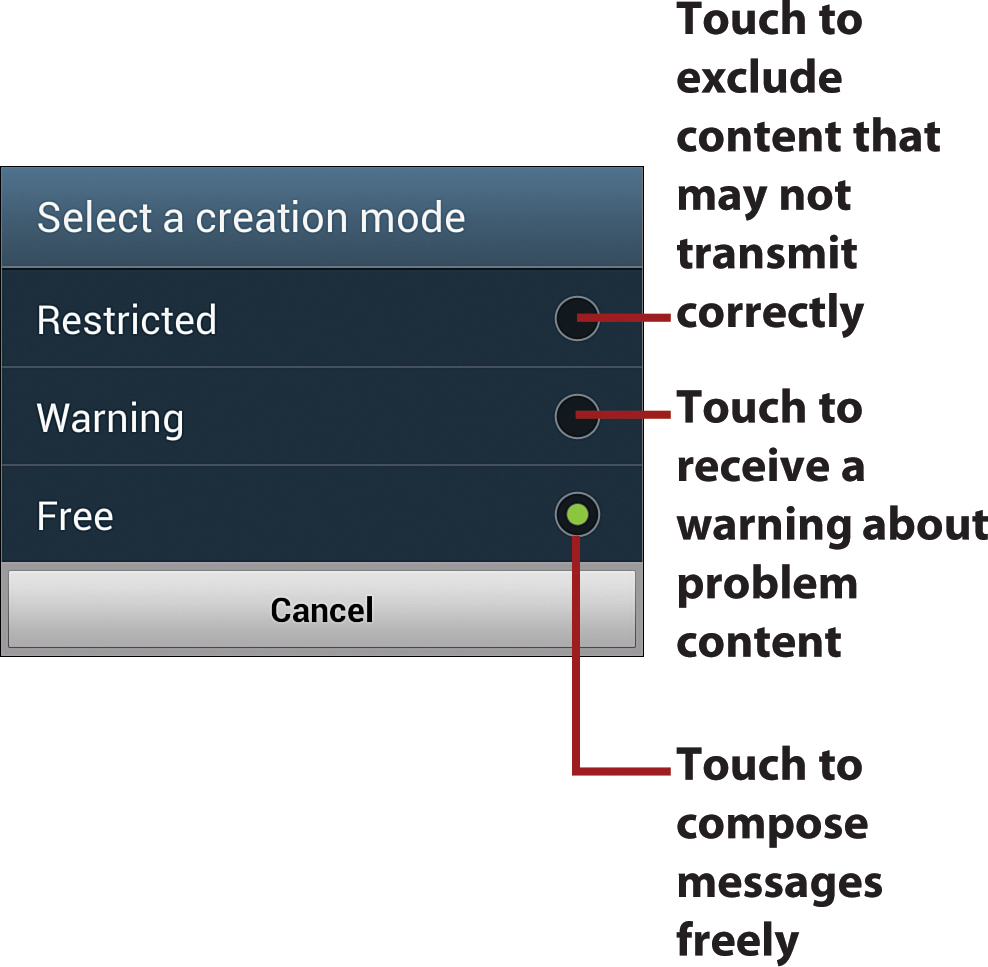
25. Touch to enable or disable receiving Citizens’ Band (CB) messages.
26. If you enable receiving CB messages, touch to configure the channels on which you receive them.
27. Touch to enable or disable receiving notifications when messages arrive.
28. Touch to select the ringtone that announces incoming messages.
29. Scroll down for more settings.

30. Touch to enable or disable vibration for message notifications.
31. Touch to choose how often your Galaxy Note II repeats a message alert. Your choices are Once, Every 2 Minutes, or Every 10 Minutes.
32. Touch to enable or disable the display of a preview of each incoming message in the status bar.
33. Touch to enable or disable adding a signature to each message you send. A signature is predefined text—for example, a sign-off salutation and your name.
34. If you enable adding a signature, touch this button and then enter the text of the signature.
35. Touch to enable or disable the settings for detecting spam messages. Spam messages are unwanted commercial messages.
36. If you enable spam settings, touch to register a phone number as a sender of spam. Your Galaxy Note II then blocks this number.
37. If you enable spam settings, touch to build a list of phrases that identify messages as being spam.
38. Scroll down to reach the final setting.
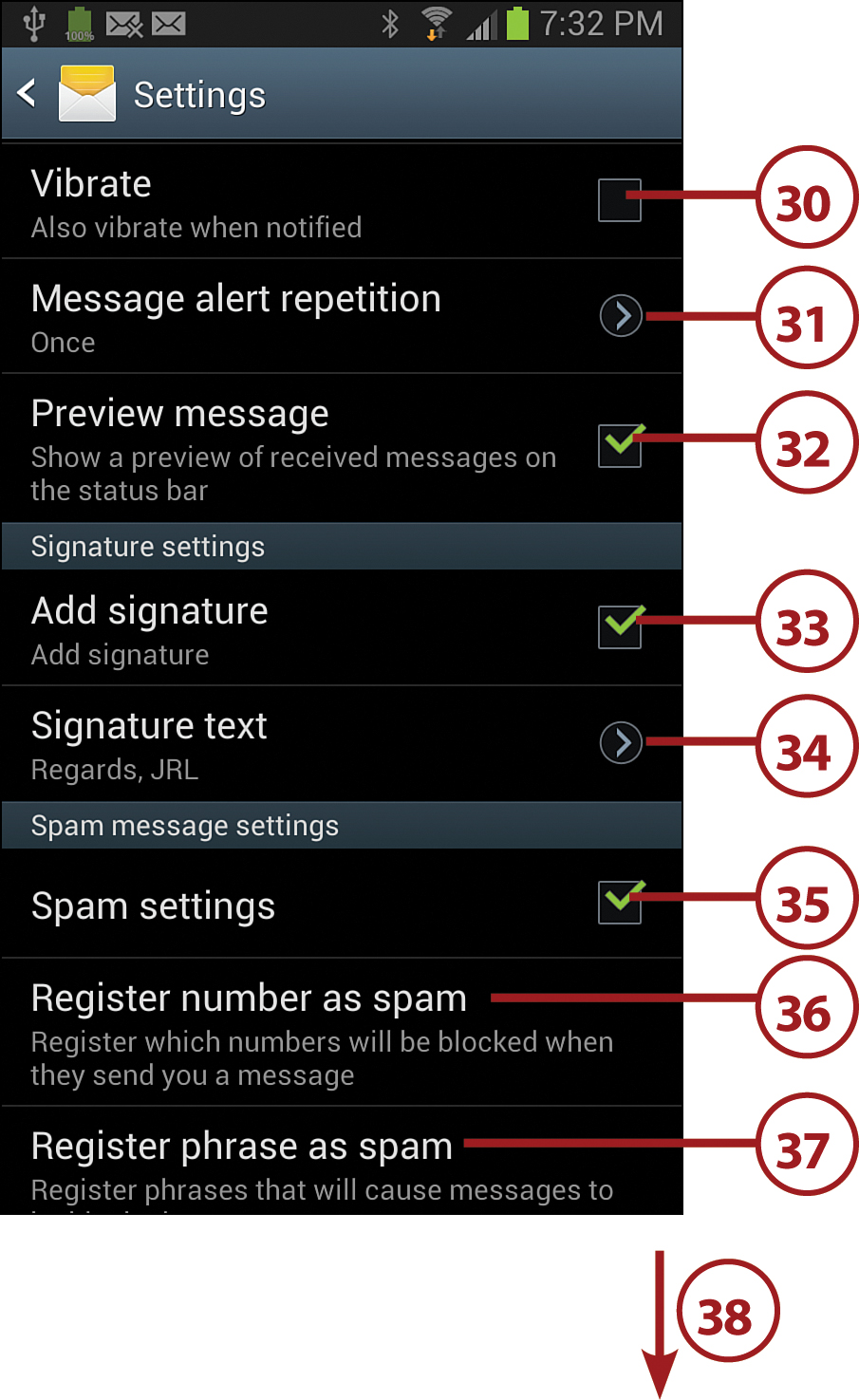
39. Touch to enable or disable blocking of all senders who are not in your contacts.

Compose Messages
When you compose a new message, you do not need to make a conscious decision whether it is an SMS message or an MMS message. As soon as you add a subject line or attach a file to your message, your Galaxy Note II automatically treats the message as an MMS message.
Here is how to compose and send messages.
1. Touch to compose a new message.

2. Start typing the recipient’s phone number, or if the person is in your contacts, type the name. If Android finds a match, touch the mobile number.

3. Touch and start typing your message.
4. Touch to send your message.

Inserting Smiley Icons
To insert smiley icons (or emoticons), touch the Menu button and then touch Insert Smiley. In the Insert Smiley dialog, scroll down if needed, and then touch the smiley you want to insert.
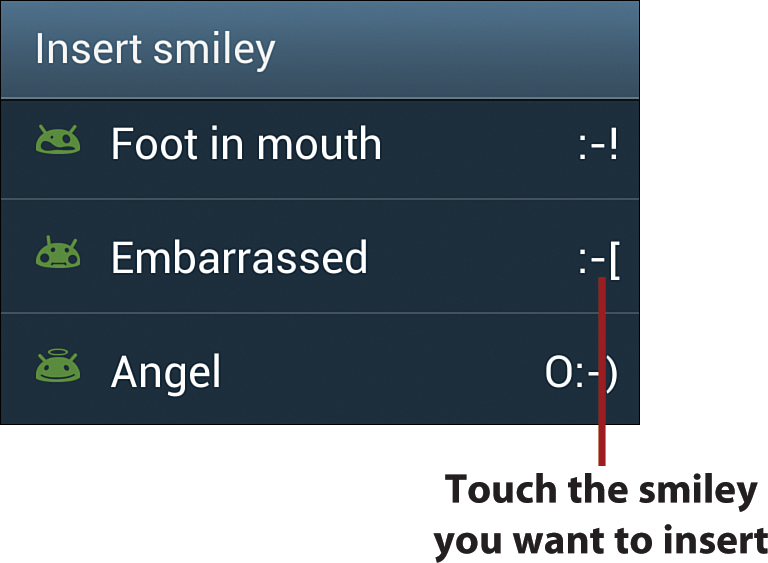
Attach Files to Messages
If you want to send a picture, audio file, or video along with your text message, all you need to do is attach the file. Attaching a file turns your SMS message into an MMS message.
1. Touch to attach a file.
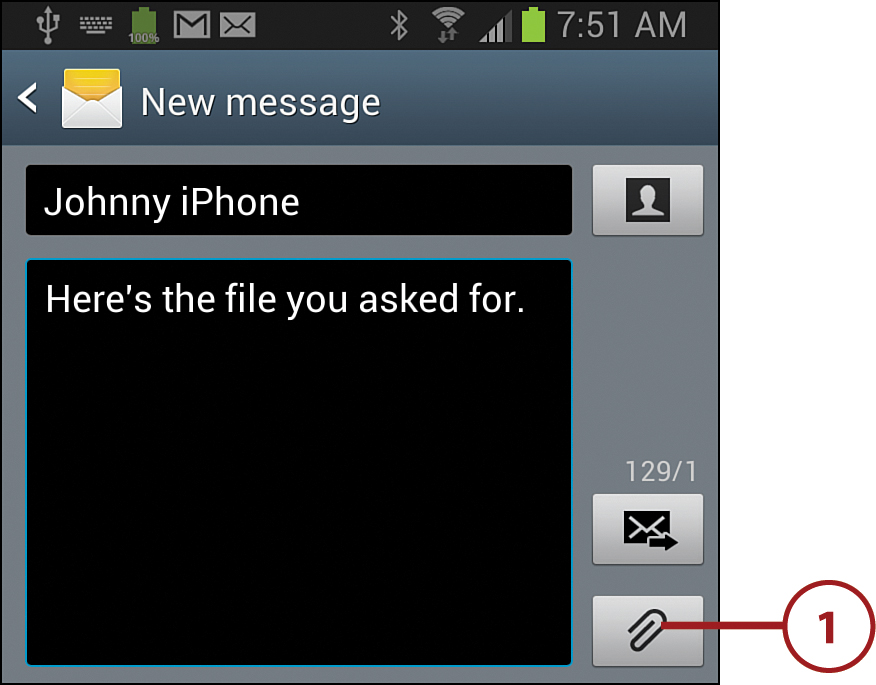
2. Touch to attach a picture already stored in your Gallery app.
3. Touch to take a picture and attach it.
4. Touch to attach a video already stored in your Gallery app.
5. Touch to capture a video and attach it.
6. Touch to attach an audio file that is already stored on your Galaxy Note II.
7. Touch to record audio and attach it.
8. Touch to attach an S Note document.
9. Touch to attach an S Planner item.
10. Touch to attach your location.
11. Touch to attach a contact record from the Contacts app.

Receive Messages
When you receive a new SMS or MMS message, you can read it, view its attachments, and even save those attachments to your Galaxy Note II.
1. When a new SMS or MMS message arrives, your Galaxy Note II plays a ringtone and displays a notification in the status bar.
2. Pull down the notification shade to see newly arrived messages.
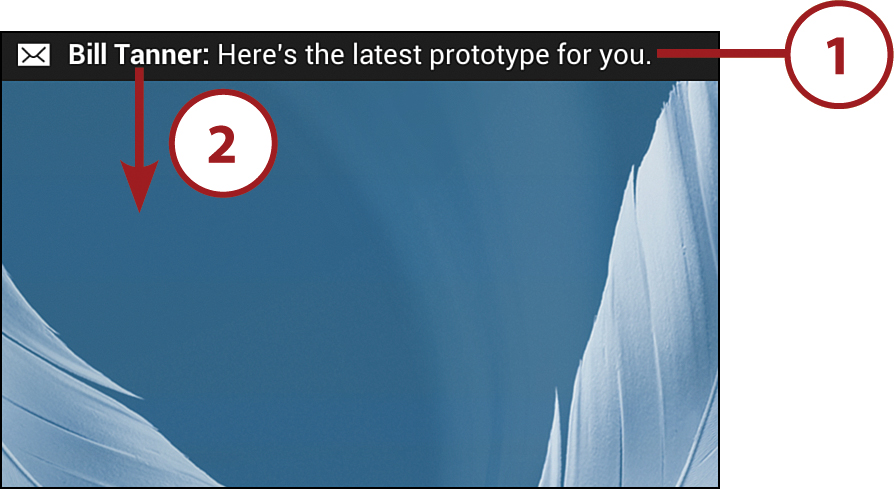
3. Touch a message alert to display the Messaging app.
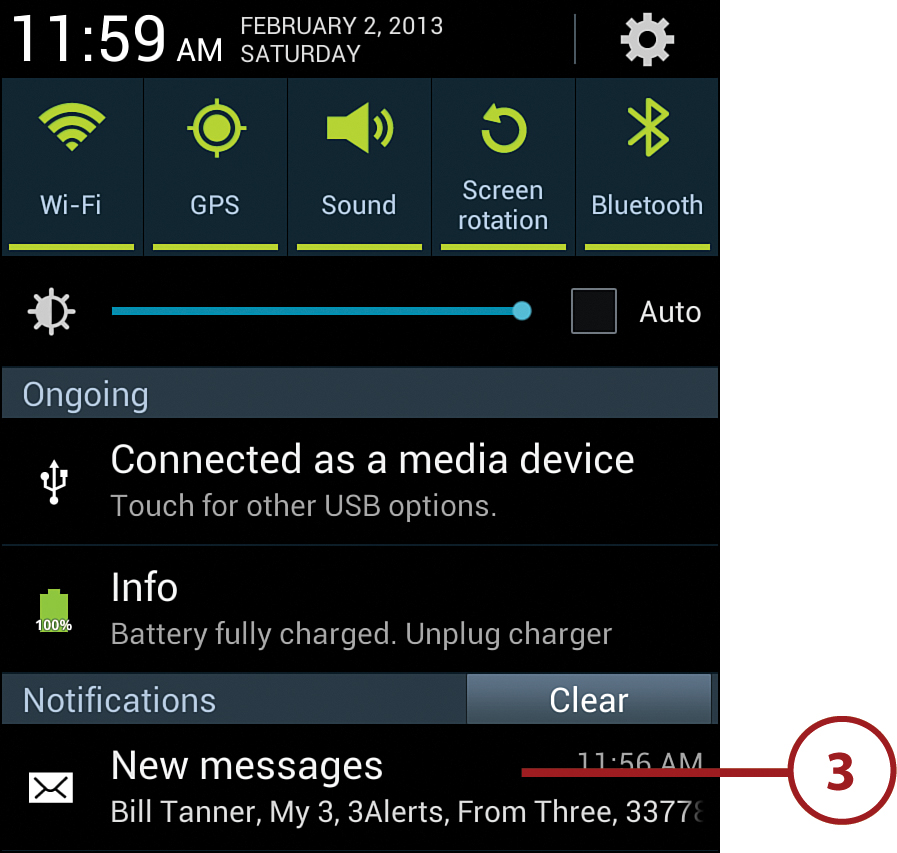
4. Touch to display the message.
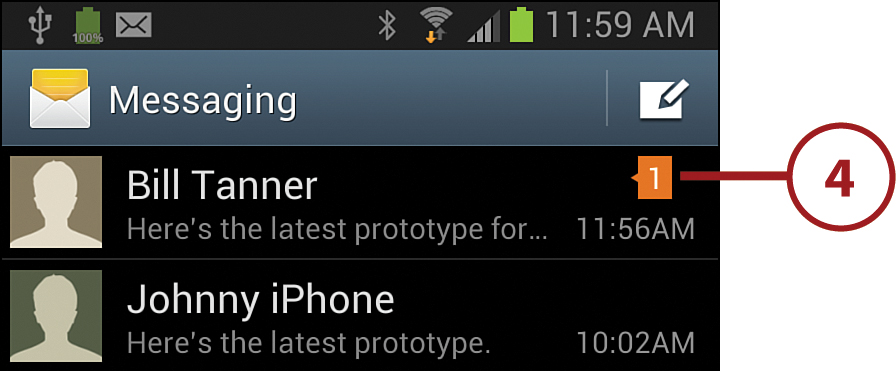
5. Touch an attachment to open it for viewing.
6. Touch and hold a message to display the Message Options dialog. Skip to step 8 for more about the additional options.
7. Touch to write a reply to the message.

8. Touch to delete the message. This deletes just the message and not the entire thread.
9. Touch to copy the message text so you can paste it elsewhere.
10. Touch to lock the message against deletion.
11. Touch to save the attachment to your Galaxy Note II.
12. Touch to forward the message and attachment to someone else.
13. Touch to view the message details, such as its size and the date and time it was sent.

Usable Content
If a text message contains links to websites, phone numbers, or email addresses, touching those links makes the Galaxy Note II take the appropriate action. For example, when you touch a phone number, your Galaxy Note II calls the number; when you touch a web link, the Galaxy Note II opens the page in Chrome or your other default browser.

